 |
|

|
 |
TABLE of CONTENTS
 |
Worker Memorial Day events held around Minnesota |
By Rich Kemp
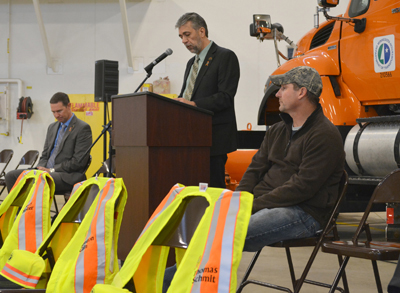
Jeff Vlaminck, District 6 engineer, spoke during the Worker Memorial Day event April 28 in Rochester. Photo by Rich Kemp |
On Monday, April 28, employees from around the state honored fallen workers who died while working on MnDOT construction and maintenance projects. Several Worker Memorial Day events were held around the state.
“These tragic deaths are terrible reminders of the dangers men and women face every day, while they keep Minnesota’s roads safe for all of us,” said Gov. Mark Dayton. “Today, we mourn their loss, honor their courage, and recognize the sacrifices of their loved ones."
Since 1960, 34 MnDOT employees and 15 private sector contractors have lost their lives on the job while working on Minnesota highways.
The day started with an event in Rochester at the District 6 maintenance facility. Jeff Vlaminck, District 6 engineer, was the master of ceremonies for the event. Speakers for the event included Eric Davis, chief of staff; Russell Hess, Southeast Minnesota Area Labor Council; Randy Staver, Rochester City Council president; and Lt. Christina Bogojevic, Minnesota State Patrol.
Chairs were set up with a vest and hat to represent the six District 6 employees who lost their lives on the job.
“These are very tragic events felt by their co-workers, family and friends,” said Vlaminck. “Something like this is difficult to forget and remains in a person’s heart forever.”
Loren Tews, District 6 maintenance, talked about a crash he was involved with in January. A vehicle lost control and hit Tews’ snowplow head-on. Fortunately no one was injured.
“We receive a lot of training and work hard to make sure that all come home safely each day,” said Tews.
In Mankato, Chris Hanson, AFSCME Local 280 president, spoke on behalf of highway workers. Also speaking were representatives from the Mankato Building Trades, OSHA, county law enforcement and the South East Labor Council.
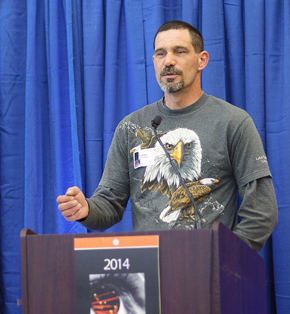
Lloyd Law, Maryland Truck Station, spoke at the Metro Worker Memorial Day event at the Chaska Truck Station April 28. He talked about an incident in February in which a car crossed over the center line and hit Law’s truck head on. Photo by David Gonzalez |
The Metro District honored fallen workers at the Chaska Truck Station. Bev Farraher was master of ceremonies. Speakers at the event included Commissioner Charlie Zelle; Metro District Engineer Scott McBride; Lt. Tiffani Nielson, Minnesota State Patrol; Tim Worke, Association of General Contractors; and Mike Lindholt, AFSCME Local 221 president.
Lloyd Law, Maryland Truck Station, was keynote speaker. He talked about driving on Hwy 8 in Lindstrom Feb. 24 in a MnDOT tractor trailer. A car crossed over the center line and hit Law’s truck head on. The driver of the car was killed.
“Everything can change in the blink of an eye,” said Law. “The only things we can do as people are prepare and handle those moments to the best of our ability. I was glad my work zone was a 50,000 plus pound vehicle at that time and it was set up properly. However, in the blink of an eye lives were changed.”
Family members of fallen MnDOT employee Ed Stary, Jr., who died as a result of a motor vehicle crash on June
10th, 2004, were at the event to honor their loved one.
The Metro District also recognized individuals who go above and beyond to ensure work zone safety. Honored for their efforts were Jennifer Johnson, Pat Nagel, Donald Machacek, John Stipe, Roosevelt Johnson and the Eden Prairie Truck Station, and Ron Swartzer and the Chaska Truck Station.
At the Metro District event, 34 chairs with vests, hats and gloves were set up to honor MnDOT employees who lost their lives. At the Central Office, a chair with a vest, hat, and poster was stationed on each floor by the elevators.
Each event included 10 seconds of silence to honor the workers and their families.
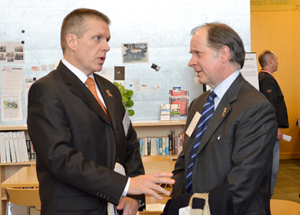
Tim Worke, Association of General Contractors, spoke with Commissioner Charlie Zelle during a Worker Memorial Day event at Egan Company April 28 in Brooklyn Park. Photo by Rich Kemp |
Commissioner Zelle and Gov. Mark Dayton also attended an Egan Company Worker Memorial Day event in Brooklyn Park to honor two Egan employees who were killed while working on a highway project in 2011.
“The ceremonies come at a time when crews are beginning work on several road projects around the state,” Zelle said. “MnDOT will be working on more than 300 state highway construction projects throughout Minnesota this year—that equates to a lot of orange barrels.”
A recorded message from Deputy Commissioner Sue Mulvihill was played in MnDOT offices statewide.
For more information on Worker Memorial Day and to listen to Mulvihill’s message, see: www.dot.state.mn.us/const/tools/workermemorial.html.
|
 |
|

|
 |
TABLE of CONTENTS
 |
MnDOT identifies project savings, will fund two major road work projects |
By Sue Roe
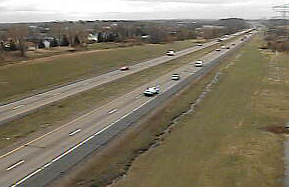
MnDOT will use project savings from the St. Croix Crossing and Red Wing Bridge projects to make improvements on I-494 in Plymouth. As part of the project, MnDOT will reconstruct pavement, replace six bridges, repair 11 bridges and add a general purpose lane from Hwy 55 to I-94 on both sides of the road. Photo from MnDOT traffic camera |
MnDOT announced April 28 that it has identified $50 million in construction project savings that will allow it to fund a major project in the Twin Cities metro area and much needed pavement reconstruction on Interstate 90 in southwestern Minnesota.
“Many people talk about reform. We do it,” said Gov. Mark Dayton. “The cost savings MnDOT has achieved by working smarter and faster are the kind of improvements Minnesota taxpayers deserve. I congratulate Commissioner Zelle, MnDOT's employees, and the private contractors, who made this accomplishment possible.”
Of the $50 million in savings, $30 million will come from work on the St. Croix Crossing project that is funded by MnDOT. The project team managed issues such as advancing parts of the project schedule and enhancing the design of highway bridges on the Minnesota side to reduce project costs. The Red Wing bridge project realized $20 million in cost reductions by adjusting the design to meet future capacity needs. That project, a replacement of the Eisenhower Bridge over the Mississippi River in Red Wing, is scheduled to begin construction in 2018.
“Our engineers and finance managers worked hard to identify potential savings in the St. Croix Crossing project and the Red Wing bridge project,” said Commissioner Charlie Zelle. “By ensuring that the designs for those projects were as efficient as they could be, we were able to reduce total project costs by $50 million. And we are finding these efficiencies without compromising safety. This shows how MnDOT is working to make the most of public resources.”
The projects that will receive the additional funding are:
- I-494, from I-394 to I-94. MnDOT will reconstruct pavement, replace six bridges, repair 11 bridges and add a general purpose lane from Hwy 55 to I-94 on both sides of the road. MnDOT will apply $25 million of the identified savings as well as program funding from the MnDOT Metro District to pay for the $86 million project. This project will start in 2015 and be completed by fall 2016 pending inclusion in the Met Council Transportation Policy Plan.
- In Greater Minnesota, MnDOT will rebuild 50 miles of pavement on I-90 for $50 million. MnDOT will apply $25 million of the identified savings to augment $25 million of previous state program funding. The improved roadway will have a life span of 35 years or more. The project will start this year and be complete by 2015. It is one of a series of MnDOT projects in that corridor that will improve 100 miles of I-90 pavement by 2018. I-90 is a major freight corridor that runs across southern Minnesota.
“The future of transportation funding will bring great challenges in the next 20 years,” Zelle said. “Our latest state highway investment plan indicates that we will be $12 billion short of where we want to be. To ensure that we are getting the most for the public’s money, MnDOT will continue to make sure that the work we do provides the best return on investment.” |
 |
|

|
 |
TABLE of CONTENTS
 |
Hwy 62 bridge uses pre-cast deck panels to save time, enhance quality |
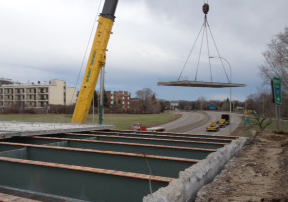
Crews move a pre-cast bridge panel into place on the Xerxes Avenue Bridge over Hwy 62 April 26 in Richfield. Photo by courtesy of the Bridge Office |
Trucks loaded with pre-cast bridge deck panels arrived at the Xerxes Avenue Bridge over Hwy 62 early Saturday, April 26. Hwy 62 was closed while the deck panels were unloaded and put into place.
In all, 28 deck panels were placed onto the steel girders from 6 a.m. to 11:30 p.m. These panels will be grouted at the joints and then compressed together with steel cables to make up a continuous roadway surface over Hwy 62. While there will be some cast-in-place concrete at the bridge ends, the majority of the bridge deck will have been made months in advance of the bridge closure, saving time and enhancing quality.
Usually bridge decks are constructed onsite. They are formed to the existing beams, steel reinforcement is placed, and concrete is cast and cured on the formwork and reinforcement. After curing a minimum of seven days, the deck forms are removed. Pre-cast bridge decks take much of the onsite and over traffic operations away from the operation. There are numerous safety benefits and the traveling public sees fewer travel delay impacts.
“The biggest advantage to using the pre-cast deck panels is the speed of construction,” said Paul Pilarski, Metro Region Bridge construction engineer. “There is less closure of the roadway, there is better quality control and the result is the bridge deck will last much longer. This project will take a little longer because we are still developing the pre-cast technology.”
After the deck panels were installed, Hwy 62 re-opened on Monday morning.
The project is part of a two-year bridge repair project on Hwy 62 in Richfield. The Penn Avenue Bridge was completed in 2013. The Xerxes Avenue Bridge is expected to open in early July.
A normal cast-in-place bridge deck takes five to six weeks. The fastest bridge deck construction recently was accelerated with incentives to as little as three and a half weeks.
A pre-cast bridge deck has the potential to reduce deck construction by 50 percent as showcased in this video of a bridge project in Utah produced by the MnDOT Video Services: www.youtube.com/watch?v=s008eF4a7ik. The entire Utah bridge deck was replaced in seven days.
For more information, or to sign up for email project updates, visit the project website at www.dot.state.mn.us/metro/projects/hwy62pennandxerxes |
 |
|

|
 |
TABLE of CONTENTS
 |
Ice delays 2014 lake, river shipping seasons |
By Greg Ruhland, Office Frieght and Commercial Vehicles

The Stewart J. Cort was the first towboat to arrive at the Duluth Seaway Port Authority this spring. The boat arrived on April 14. Photo courtesy of Ken Newhams, Duluth Shipping News |
On land, spring may have arrived. However, on Lake Superior, the navigation season just can’t escape winter.
The lake shipping season opened later than expected at the Duluth Seaway Port Authority when the first towboat, the Stewart J. Cort, arrived April 14 for the Burlington Northern Santa Fe railroad to load iron ore pellets.
“Despite its delays, waterway shipping is still the least expensive way to ship commodities,” said Patrick Phenow, incoming Ports and Waterways program coordinator. “Minnesota’s waterways are an important part of a coordinated, interdependent transportation system.”
In the Twin Cities, the first ship of the season on the Mississippi River arrived April 15 at the St. Paul Port Authority. The Angela K of SCF Marine out of St. Louis, Mo., officially opened the river shipping season, hauling four loaded and eight empty barges. River ports include Minneapolis, Red Wing, St. Paul, and Winona. Rivers transport primarily agricultural products—corn, soybeans and wheat. Minnesota’s 223-mile river system includes the Mississippi, St. Croix and Minnesota rivers.
“We’ve never seen these [icy] conditions this far into spring,” said Adele Yorde, Duluth Seaway Port Authority public relations manager.
This year, the Stewart J. Cort, normally just 24 hours in transit, took three days to get through the Soo Locks at Sault St Marie, Mich., which connect Lake Superior and Lake Huron. The full Great Lakes shipping season begins when these locks open typically March 25 each year.
“On the 25th, they opened and there wasn’t a ship in sight,” Yorde said. “Conditions are improving slightly, but 30 percent of Superior is still covered with ice.”
That extra ice cover slowed evaporation and raised lake levels a foot above where they were last year at this time.
Fortunately, that will allow some of the ships to load heavier and deeper, Yorde said. A typical barge carries 1,500 to 1,650 tons of freight—15 times more freight than a rail car and 60 times more freight than a truck. One gallon of fuel can move one ton of freight 514 miles on the river.
Taconite accounts for more than half the freight shipped on lake ports; coal is second, with about 25 percent moved on Lake Superior. Other products handled include cement, steel products, minerals, salt and packaged goods. Minnesota ports on Lake Superior—Duluth/Superior, Two Harbors, Taconite Harbor and Silver Bay—shipped more than 68 million tons in 2013, 53 million of which was outbound.
MnDOT administers the Minnesota Port Development Assistance Program, which since 1996 has made state funds available to rehabilitate Minnesota’s public port facilities. For more information, check out the Minnesota's ports and waterways website. |
 |
|

|
 |
TABLE of CONTENTS
 |
Adopt a Highway volunteers help keep Minnesota beautiful |
|
By Mary McFarland Brooks

Ernest Lloyd coordinates the Adopt a Highway program that saves the state of Minnesota approximately $6 million annually. MnDOT file photo |
This year is the 44th anniversary of Earth Day and the 24th anniversary of MnDOT’s Adopt a Highway program, which was established in 1990 by Gov. Rudy Perpich and former MnDOT Commissioner Len Levine.
The Adopt a Highway program is a public service campaign where community groups, churches, businesses, and individuals pick up litter along Minnesota highways.
“The program enables environmentally conscious citizens to make a personal contribution to a cleaner environment,” said Ernest Lloyd, Adopt a Highway program administrator. “Thanks to these dedicated volunteers and their organizations, our department can use the resources that would have been used to pick up litter for highway improvement and safety projects.”
In the 24 years since its introduction, the program saved the state of Minnesota approximately $6 million annually. In 2013, volunteers picked up 826,000 pounds—more than 100 dump truck loads—of litter.
The Adopt a Highway program currently is staffed by more than 49,000 volunteers who are helping to clean up more than 11,000 lane miles of Minnesota’s highways. The program saw an increase of 12 volunteers groups and more than 120 volunteers in 2013.
Even with these great efforts, MnDOT is looking for more volunteers to help with this public service campaign, Lloyd said. To become part of the program, the volunteer groups agree to:
- Adopt a highway for a minimum of two years
- Select a segment of highway approximately two miles in length
- Pick up litter on both sides of the highway
- Pick up litter as often as needed from spring through fall, usually two to three times
MnDOT provides a safety training video and safety vests for each volunteer and trash bags for cleanup events. The high-visibility color and reflective tape help make litter crews visible to passing motorists.
After the group completes its cleanup, MnDOT crews pick up the filled bags and large, heavy or hazardous items from the roadside. State workers, not volunteers, are responsible for litter pickup along the interstate.
Also available for those interested in learning about the program is, “Pick A Highway,” which allows an individual, family, business or group the option of trying out the program with a one-time pickup of litter along an unadopted section of state highway.
Those interested in adopting a highway can visit: www.mndot.gov/adopt/contacts.html |
 |
|

|
 |
TABLE of CONTENTS
 |
Materials lab celebrates 25 years with open house |
By Shannon Fiecke, Research Services & Library
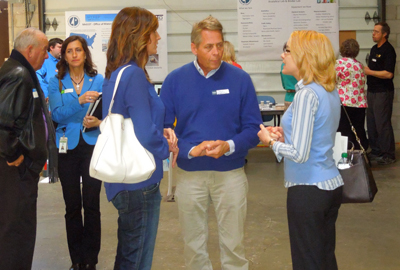
From left: Pat Hughes, retired Operations Division director; Nancy Daubenberger, state bridge engineer; Amy Grothaus, Braun Intertec; John Garrity, bituminous engineer; and Jill Thomas, MAPA director; attended the open house for the 25th anniversary of the Office of Materials and Road Research April 8. Photo by Lisa Bilotta |
MnDOT’s Office of Materials and Road Research celebrated its 25th anniversary April 8 with an open house at its Maplewood facility.
The materials lab researches and implements cost-effective construction procedures, designs and maintenance practices for the state’s infrastructure. It inspects all materials used in state construction projects, provides geotechnical engineering services for bridges and other structures and provides technical expertise on pavements.
“Our mission over the years to provide timely, specialized expertise to our customers has not changed,” said OMRR Director Glenn Engstrom. “However, the tools and the advanced technology used by our dedicated staff has changed tremendously.”
During the course of its 25 years, the office pioneered the use of new technologies, including pavement management vans, the cone penetration test truck, the high-speed profilometer, pavement-tire noise testing equipment, ground penetrating radar, X-ray fluorescence spectrometer, and electrical resistance imaging.
“These tools helped us deliver the program far more effectively and resulted in real cost savings to the public,” Engstrom said.
Key projects at the lab this year include: an AASHTO national transportation product evaluation; implementation of intelligent compaction and thermal bar imaging on more than 20 projects statewide; a thin, four-inch bonded concrete overlay project in Willmar; the implementation of a cold weather performance test for asphalt quality; and continued support for the St. Croix Crossing project.
The lab’s pavement testing facility, MnROAD, also has a milestone this year. It will commemorate its 20th anniversary at an open house on Aug. 6.
|
 |
|

|
|

|
 |
TABLE of CONTENTS
 |
On the Job: When history and construction meet, Linda Pate is there |
By Sue Roe

Linda Pate is a historian in the Office of Environmental Stewardship’s Cultural Resource Unit and MnDOT’s liaison to the Army Corps of Engineers. She is a MnDOT employee, but is contracted out to the Army Corps. Photo by Sue Roe |
When MnDOT County State Aid Highway construction projects cross waterways and could affect historic properties, Linda Pate is called into action. Pate is a historian in the Office of Environmental Stewardship’s Cultural Resource Unit. She’s also the liaison to the Army Corps of Engineers, splitting her time between both places. She is a MnDOT employee, but is contracted out to the Army Corps.
Pate’s background is a unique blend of history and construction. She graduated from the University of Minnesota with a double major in history and women’s studies. At the time, history jobs were hard to find, so Pate, a Texas native, went into construction and later got her master’s degree in history from Indiana University. After graduate school, she worked as a timber framer and historic site manager in New England. She worked for the Minnesota State Historical Preservation Office before coming to MnDOT about two years ago.
What are your main job responsibilities?
I conduct Section 106 reviews for County State Aid Highway projects that do not have federal funding and require a U.S. Army Corps of Engineers permit. A Section 106 review is a cultural resource review, which is part of the National Historic Preservation Act. The Act requires federal agencies to consider the effects of projects they carry out, approve or fund on all properties considered eligible or listed on the National Register of Historic Properties. A review doesn’t mandate preservation because sometimes there is no way for a project to proceed without impacting historic properties. But the review does make sure that preservation values are factored into federal agency planning and decisions.
My other main responsibility is to review MnDOT district projects that use only state funds. State law requires that projects funded with state dollars consider the impact on properties listed on the National Register. A property may be eligible for listing, but if it is not already listed, it is not reviewed.
When does the Army Corps of Engineers get involved in MnDOT work?
The Corps gets involved when a proposed project impacts the waters of the U.S., either navigable waters or wetlands. When construction projects cross waterways or bodies of water, a Corps permit is needed. MnDOT projects, mining projects and individuals who want to build docks on their lake property are examples of work that needs a Corps permit. When a project uses only state funds and requires a Corps permit, I review the whole project according to state law and then the Corps Regulatory Division reviews the part of the project that the Corps considers to have an effect on the waters of the U.S. For example, a six-mile stretch of road reconstruction might pass through wetlands and cross a river. MnDOT CRU makes sure the whole project meets state law and then the Corps makes sure the project meets federal law in the areas that impact the wetlands and river.
What challenges do you face?
Since I split my time between the MnDOT Central Office and the Army Corps office, working in two different places with two security cards, two email addresses, two regular mail addresses, three phones, and six passwords is a challenge. Also, two computers that do not tolerate each other’s firewalls is a challenge. One of the biggest challenges was learning all the acronyms and processes of two large organizations while clearing a sizable backlog of projects that was waiting for me when I started the job.
What do you enjoy most about your job?
I enjoy being a part of a multifaceted statewide organization like MnDOT because it gives me the opportunity to learn about all different parts of the state and work with some great people. Reviewing projects and studying historic properties requires my historian side and my builder side to think and work together. The variety of people, projects and places also keeps me engaged. During my first year, I traveled to every district to meet with county engineers to let them know about the new position. I always enjoy a road trip and I got to learn, in person, about some of their frustrations with the Corps permitting backlog. Also, getting to know people throughout MnDOT by working on projects and serving on committees is a very nice part of my job.
What are you working on now?
I’m working on approximately eight projects, mostly small, non-historic bridge replacements and a few road improvement projects throughout the state. The majority of my projects are bridge replacements in mostly rural areas, over wetlands and creeks.
Do you or a co-worker have an interesting job to share with readers? Click here to send us your ideas, and we’ll contact you for more information.
Recent employee profiles:
|
 |
|

|
 |
TABLE of CONTENTS
 |
Sheila Hatchell recognized for ROI work |
By Shannon Fiecke, Research Services & Library

Sheila Hatchell, library director, was recognized in March with an Innovation Award from the Special Libraries Association’s Transportation Division. Photo by Nick Busse |
Librarians are not thought of as having a crucial role in the building of a road, bridge or trail, but it is a different story in the state of Minnesota.
Each day, the MnDOT Library locates obscure, but important information for engineers and transportation practitioners, such as the safety aspects of extra-tall concrete median barriers, the travel patterns of blind pedestrians and the environmental impact of treated lumber used on freeway noise walls.
“I like to say, ‘Google gets the easy stuff and we get the really difficult stuff,'” said Sheila Hatchell, library director.
Hatchell was recognized in March with an Innovation Award from the Special Libraries Association’s Transportation Division for helping transportation libraries demonstrate the value of this work.
With few good examples to follow, Hatchell and two peers set out to develop a national guidebook for quantifying the benefits of a special library, in particular, a transportation library.
“There is a wealth of studies demonstrating the value of public and academic libraries, but when it came to special libraries, there was almost nothing,” Hatchell said. “And what little there was, it didn’t pertain to state transportation libraries.”
Hatchell spent her weekends researching what other institutions have done and drafting much of the 52-page toolkit, Proving Your Library’s Value, which was published in 2013 through the Transportation Library Connectivity and Development Pooled Fund Study.
Soon after, MnDOT put her work into practice, hiring a consultant through the department’s research program to perform a return on investment study on the library.
The study determined that for every dollar spent, the library produced nearly $2 worth of value, mostly due to the dollar value of research that might otherwise be provided by a paid consultant. The dollar figure doesn’t include the intangible value such information provides transportation projects.
In 2012, the MnDOT Library responded to more than 2,100 requests for information, many of which took days or weeks to track down. It also loaned out nearly 3,800 items, routed 10,887 journal issues and distributed more than 560 journals and books borrowed from other libraries.
“A lot of people use the library and don’t even know it,” Hatchell said, since much of the data is shared with a wider audience.
Hatchell spoke about her research in early April at the Texas Library Association Annual Conference. She will receive the award at a future event. |
 |
|

|
 |
TABLE of CONTENTS
 |
District 7 holds Employee Day in Mankato |
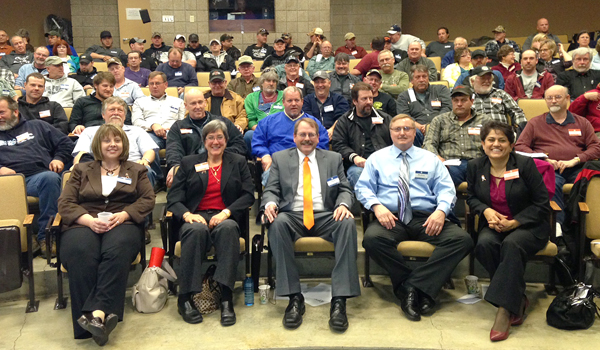
Front row from left: Tracy Hatch, deputy commissioner, chief operating officer and chief financial officer; Sue Mulvihill, deputy commissioner/chief engineer; Greg Ous, District 7 engineer; Mike Barnes, Operations Division director; and Emma Corrie, Operations Division business manager; spoke to the employees during the District 7 Employee Day April 30. Bob Filipczak, Office of Communications, gave a presentation on Generations at Work and Jonathan Zierdt, Greater Mankato Growth, spoke about Why MnDOT Matters. Photo courtesy of District 7 |
|
 |
|

|
 |
TABLE of CONTENTS
 |
What’s new on the web |
iHUB homepage
The iHUB homepage recently got a facelift. Now you can see the most recent changes to MnDOT policies, agency news, upcoming events, and the latest updates on our Enhancing Financial Effectiveness goal. Recent policy updates include the “Reasonable Accommodation” policy and “Cost Participation for Cooperative Construction Projects and Maintenance Responsibilities” policy. Check it out at http:/ihub/.
Safeguarding MnDOT
The Safeguarding MnDOT iHUB website is now available and contains information about internal controls, training, certification, and contacts.
Safeguarding MnDOT is the agency’s internal control program. It ensures the MnDOT mission, goals and objectives are achieved, while also avoiding fraud, waste or abuse of taxpayer-provided resources.
Find more details at http://ihub/safeguardingmndot/.
Data Practices
The iHUB Data Practices website has been reorganized. Employees can easily find out how to request data, what rights they have to their own data and forms to use when collecting other employees’ data and photographs. Check out the website at http://ihub/datapractices/.
New Library Materials
New Library Materials are available at www.mndot.gov/library/newlibmat.html.
The Information Extra article in this issue is about building harmony in the workplace: what extroverts and introverts need to know about each other.
New Library Materials is a compilation of new titles and other resources added to the library collection during the previous month. If you would like to be added to the distribution list, contact pamela.m.gonzalez@state.mn.us or 651-366-3749.
Previous editions of New Library Materials are archived and available at www.dot.state.mn.us/library/recacq-archive.html. For other information requests, contact the Library at 651-366-3791 or email library.dot@state.mn.us, or send requests via the “Ask a Librarian” web page at www.dot.state.mn.us/library/asklibrarian.html. |
 |
|
| |
|



